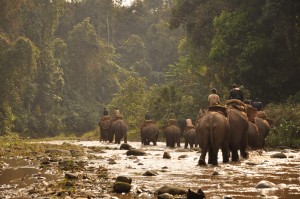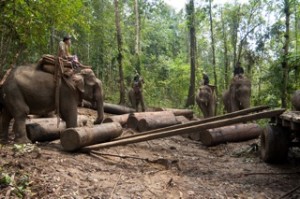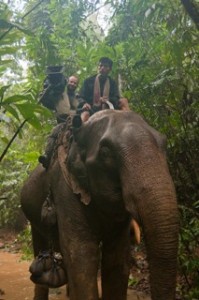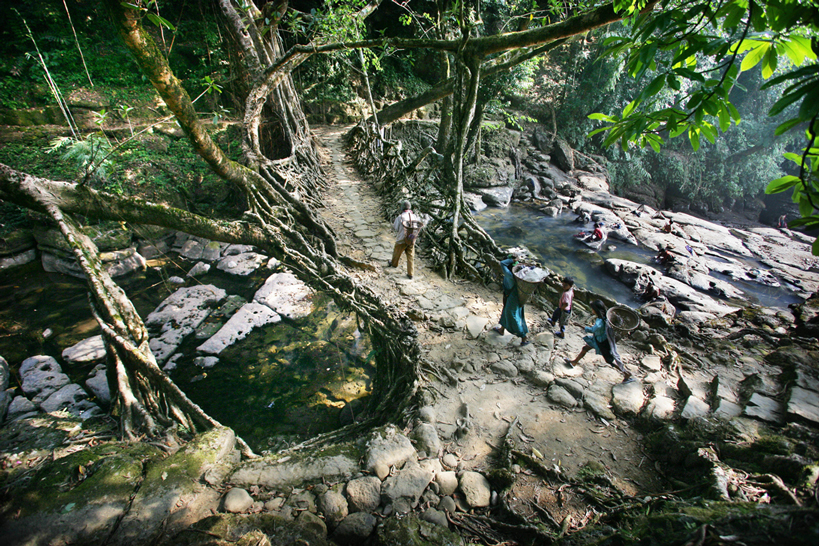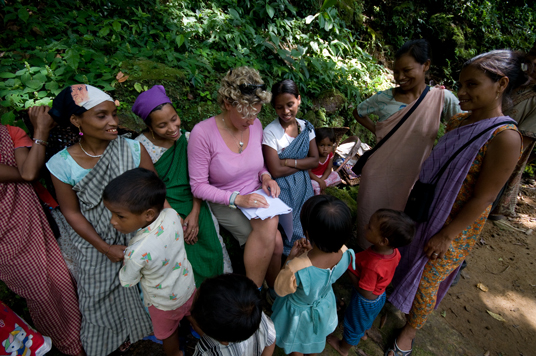The Original Jungle and its Mighty Beasts
By Rachel Kinley, Assistant Producer of Human Planet
The word Jungle itself comes from the Sanskrit word for forest. It was in this original jungle, on the borders between India and Burma, that we filmed people working with one the most iconic of jungle animals – the forest elephant.
It took us three days and several forms of transport, including a rickety old logging truck, to reach the camp which would be our home for the next two weeks. There wasn’t just us staying there though, this camp was home to a dozen elephants and their mahouts.
We were there to film them moving felled trees from the forest, as part of a sustainable logging business. Watching the elephants at work was so impressive. They are powerful beasts who can move a massive log as if it was a tiny twig. Amazing!
Being so strong, they really intimidated me at first. After we’d filmed with them for a while though, I realised that that their mahouts were well in control of these animals. So, when I was offered the chance, I jumped at the opportunity to take one for a ride. I was only allowed to travel on the female elephants so as not to spook the bulls. Our cameraman Robin however was game to ride any elephant any which way, and even learnt how to steer it along with his feet!
Spending time with these mahouts who dedicate their lives to looking after these animals was an empowering experience. This sequence really shows that the Human Planet Jungles programme isn’t just about living in rainforests, it’s about the incredible relationships people have with their environment and the species which live within.
The Human Planet Jungles and Grasslands episode can be seen on the Discovery Channel.
The Making Rivers and Oceans
Renee Godfrey, Assistant Producer on Human Planet, explains her favourite part of making Rivers and Oceans.
One of the most magical ways of living with rivers is found in the Khasi Hills of North East India; an environment, during monsoon season, engulfed by raging rivers. Searching for the secrets the deep Khasi tribal valleys and villages hold is a dream come true for any adventurous film maker.
Once a part of Assam in Northeast India, the tropically lush and verdant massif of Meghalaya stands proudly above the pancake flat plains of Bangladesh. As the Southwest Indian monsoon moves its moisture laden way up the Bay of Bengal and over Bangladesh, the Khasi Hills are the first major landmass it meets. Huge teams of nimbostratus clouds tower and linger with excited intent at having reached their destination – one of the wettest places on our planet.
With each twist and turn of the road, new and magnificent vistas are revealed. There is an air of mystery to the geography – its tropical forest draped in orchids, misty ridges, impossibly steep and seemingly inaccessible gorges, and moody rivers all begging to be explored.
During monsoon, the Khasi are faced with dealing with biblical amounts of water falling from the sky. Their traditional villages magically appear from nowhere through the enchanted forest, all cope wonderfully with days of downpours.
While the crew are all kitted out with umbrellas and waterproof jackets, Khasi society is lacking in such Gortex items, rather the women weave curved bamboo and palm leaf rain shields or ‘knub’ to protect themselves from the beatings of rain. There is also one, very unique and magical Khasi solution to coping with the rainfall; one that the Khasi are particularly proud of, and that is what I have come in search for.
During monsoon, the rivers intersecting Khasi villages swell greedily and become raging rapids washing away anything in their path. Faced with the problem that man made bridges and walkways of concrete or wood rot and are destroyed by the forces of water, the Khasi have come up with a unique and organic architectural solution using what mother nature provides - they have learnt to make living bridges from tree roots.
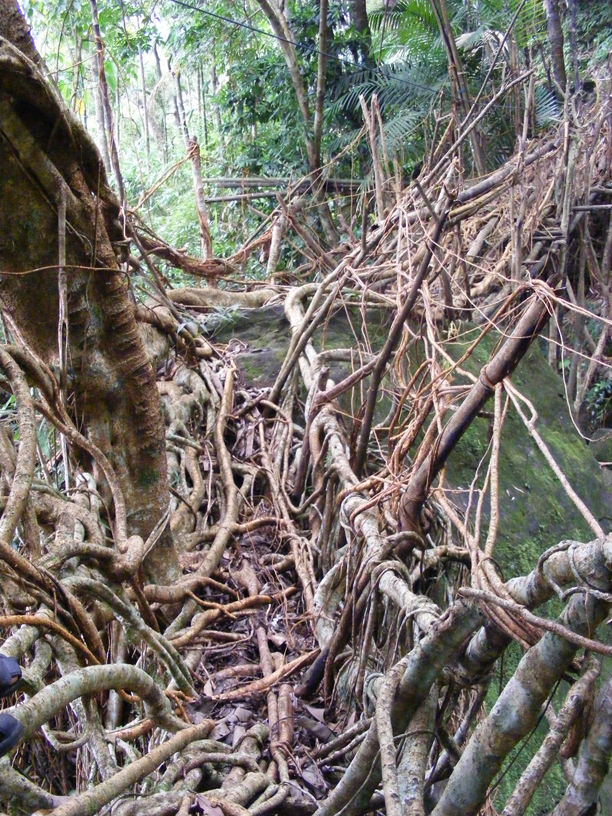
Ficus elastica, or more commonly, the Indian Rubber Tree, is a loyal and useful character in the colourful cast within the forest canopy. Perched wisely on huge boulders or alongside riverbanks, the ficus trees sit, adorned with party streamer like aerial roots. Each root shoots out in medusa style fashion, on a mission to find soils with greater stability. Well rehearsed in the shifting moods and flows of the rivers, the help of these loyal root tendrils keeps the ficus trees standing strong. By encouraging the aerial roots across impassable rivers and gorges, bridges form and areas once impassable became accessible.
To find the root bridges takes dedication and concentration. An impossibly steep and knee numbing descent takes me down through layers of forest into the enchanted Khasi world.
Local villagers have made tiny steps down the steep gorge slopes, plunging into the heart of the forest - hundreds upon thousands of pebbles smoothed by years of Khasi feet trotting up and down.
Each pebble marked by footprints of times past, each with stories to tell as they take the weight of the local tribes.
As I hop across streams, sway dramatically over rickety steel bridges with heart in throat, too scared to look down at the white water below, my curiosity drives me on. These bridges of ornate organic architecture are hidden within this fairytale forest and these endless paths will, I know, eventually unveil their wonder.
Three hours into the trek, a small perfectly manicured village, Nogkriet appears at the end of the steps. Just beyond Nongkriet, I look up and am transported into an unbelievable scene; a mix between Alice in Wonderland and Lord of the Rings – colourful spiders look on from silvery webs and at any minute I expect to see fairies dancing around the bamboos. There in all its magical glory is the 200 year old Umshiang double decker root bridge. Sitting with an omnipotent grace, the bridge is bejewelled in aerial roots of all shapes, ages and textures – like a Monarch draped in regal gold – the ficus; treasure is equally as impressive and precious.
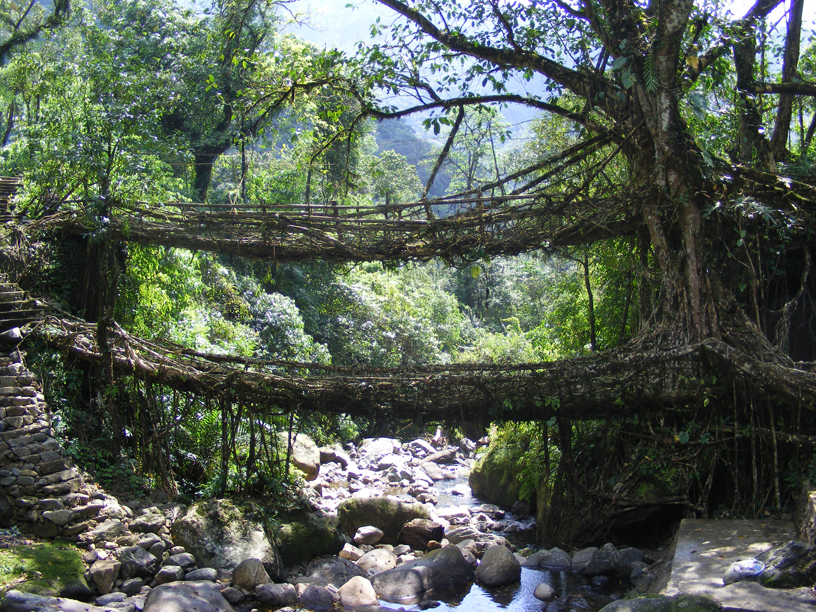
The Khasi of Nonkriet village have trained the roots of one single ficus tree on two levels across the river; the result, a surreal double decker root bridge sketched into the forest landscape like some sort of magical computer generated graphic on mother nature’s stunningly crafted film set; nature’s magic.
The Great American Grassland
by Brian Leith, Executive Producer of Human Planet
Choosing which stories to film for Human Planet was demanding: ideally we wanted to show our audiences something new and surprising – something they’d never seen before. That’s why we often went for dramatic eye-popping moments from half-way around the world…but there were also times when we could have chosen stories from right under our noses – stories which we’d all heard about, but which were just as amazing as anything you’d find 10,000 miles away.
For the Grasslands episode I kept thinking about a filming trip I’d made 15 years ago in one of America’s most beautiful – if surprising – landscapes: the high plains of Oklahoma and Kansas. This was the old ‘dustbowl’ country of the 1930s, the flat-as-a-pancake lands which had been settled in the late 19th and early 20th century with grants of free land to anyone prepared to try and make a living there.
And the settlers came! Those were troubled years in Europe and tens of thousands of immigrants came to this promised land, grateful to have the chance to make an honest living growing their own crops on their own land, enjoying freedom and the open-armed welcome of their newly adopted nation.
But it wasn’t easy. This was also a brutal land – suffering extremes of weather and climate on top of a thin soil which (if truth be told) was never really going to support much wheat or livestock. It was classic Human Planet: people pushed to the very limits of their ingenuity and bravery, attempting to forge a life for themselves in the most trying of circumstances.
And we all know what happened. The winds came, the topsoil blew away, and grasslands that were never really capable of growing vast fields of grain on such an intensive scale turned to dust, along with the dreams of those settlers, many of whom were forced to move on westwards towards another promised land.
But that’s not the end of the story.
The people I met on those plains 15 years ago were the descendants of the dustbowl survivors – the ones who’d stayed and stuck it out. They’re among the most impressive people I’ve ever met: hard-working and determined, people who know their land – its potential and its limitations – much better than most of us. They are as impressive survivors as anyone we filmed for Human Planet.
I’m often struck by how it’s just such people - with tough lives – who often show the greatest generosity and kind-heartedness. I made one or two friends on that filming trip who remain friends to this day: people who persuaded me to stay and enjoy a good meal and a conversation rather than drive back to my distant motel.
